Chinese Tallow Tree - Invasive Plant
General Information
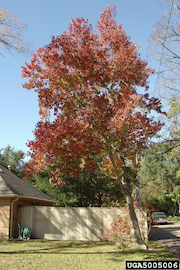
Chinese tallow tree (Triadica sebifera (L.) Small) is a short-lived, fast growing tree native to eastern Asia (Figure 1) that has become naturalized through the southeastern U.S. from North Carolina to eastern Texas and in California.
Chinese tallow trees were originally introduced to the U.S. during the 1700s. Evidence indicates that it was brought as a source of oil for the soap industry.
- Chinese tallow tree tolerates a wide range of environmental conditions.
- It grows rapidly and is resistant to many pests, so that it quickly dominates sites.
- It spreads rapidly by producing abundant seeds that are spread by birds and may lay dormant in the soil for up to five years before germinating.
- Chinese tallow tree also spreads by sprouting from the roots, especially when the original stem is cut or top killed.
Where are Chinese tallow trees in Arkansas?
The Atlas of the Vascular Plants of Arkansas records Chinese tallow tree in 15 counties in Arkansas, and the USDA Plants Database adds an additional three counties to the list.
How to identify a Chinese tallow tree
Chinese tallow trees grow as a large shrub or a medium-height (but large diameter) tree – up to 60 feet (18 meters) tall and 3 feet (90 centimeters) diameter (Figure 2). The bark is light to dark gray and furrowed.
Brittle branches spread and support a crown of simple alternate leaves that range in size from 1.5 to 3.5 inches (3.8 to 8.9 cm) wide and approximately the same length. The leaf stalk is usually at least half as long as the leaf blade. Overall, leaves are nearly round to more or less kite shaped, base of the leaves is rounded, and the tip tapers to a short or long point (Figure 3). Leaves are hairless, medium green on top and slightly lighter green beneath. Leaf veins, especially the mid-vein, are lighter green on the upper surface. Leaf margins are not toothed. The leaves change to yellow, orange, or red in the fall (Figure 4).
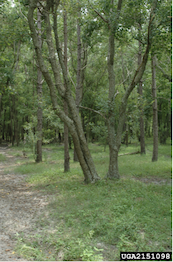
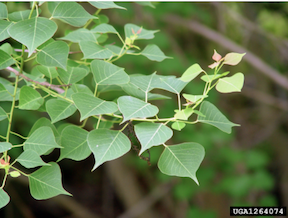
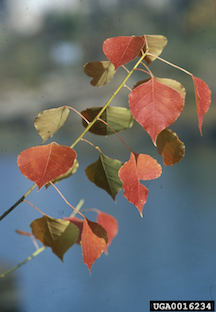
Biology of Chinese tallow trees
Chinese tallow trees flower in the spring – typically April to June. The small greenish yellow flowers of the Chinese tallow tree have no petals, so they don’t look like typical flowers. They develop in catkins 2 to 8 inches (5 to 20 cm) long in the spring. Most trees produce one catkin per branch, but occasional trees produce more. Each catkin has a few separate female flowers, occurring at the base of the catkin with male flowers filling out the remainder (Figure 5).
Fruits develop as a ¾-inch (2 cm) diameter three-lobed capsule which matures in late summer (Figure 6). As the capsule matures and dries out (Figure 7), the outer shell splits open and ultimately falls off at maturity, leaving a cluster of three to four off-white waxy seeds (Figure 8). These seeds remain attached into the winter and give the tree one of its common names – popcorn tree. One tree can produce from 50,000 to 100,000 seeds with high rates of viability. Seeds are dispersed by a variety of birds and by environmental agents such as creeks or floods. Research indicates that they are viable in the soil for at least two years and potentially up to five years.
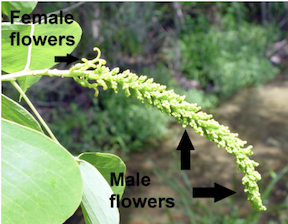
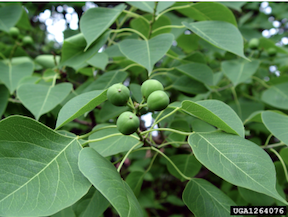
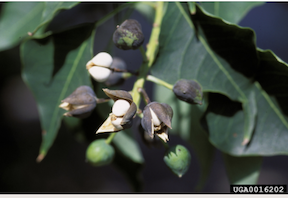
Stop the Spread of Chinese Tallow Tree
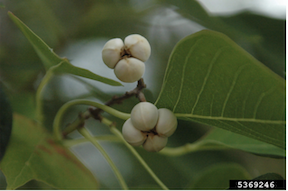
Chinese tallow tree is difficult to control because it sprouts freely and produces abundant seed. Given sufficient time, it most likely will escape cultivation.
Non-chemical control
Chinese tallow tree can be controlled by cutting and removal if one is persistent. When a tallow tree is cut, it will resprout from the stump or roots. Successful removal depends on diligently checking for sprouts and removing those sprouts promptly. Biological control has been investigated, but few pathogens or pests attack the tree.
Chemical control
For most homeowners, herbicides present a better control option. Several herbicides including 2, 4-D, fosamine, hexazinone, imazapyr, metsulfuron, and triclopyr have proven effective. Depending on the herbicide and the size of the individual tree, application can be by basal bark application, cut stump treatment, hack-n-squirt, foliar spray, or soil application. Consult your county extension agent if you have questions about specific herbicide recommendations tailored to your situation.
As with all herbicides, misuse of these chemicals can cause tremendous environmental damage and can harm you. Read and follow all label directions, including personal protective equipment recommendations.
One of the most commonly used treatments for Chinese tallow tree is a basal bark application of the ester formulation of triclopyr. Most trees can be killed with a 15% solution using vegetable oil as a surfactant. This solution should be applied as a 6” (15 cm) wide band sprayed around the tree in the lower 2 feet (60 cm) of the trunk. A 20% solution might be required to kill larger trees.
A basal bark application may not be effective on large trees with thick bark. In those cases the tree may be cut and the stump treated with 50% solution of the ester formulation of triclopyr or a 10% solution of imazapyr. Note that imazapyr is persistent in the soil, so avoid overapplication. Glyphosate applied by hack-n-squirt will also provide good control of larger trees. Use an undiluted 4 lb / gallon (0.48 kg / liter) glyposate solution applied into frills spaced 2 to 3 inches (5 to 8 cm) apart around the tree trunk.
Let’s work together to stop the spread Chinese tallow tree in Arkansas.
Resources
Here are some additional resources to learn about Chinese tallow tree.
Web Sites
Natural Area Weeds: Chinese Tallow (Sapium sebiferum L.)
BugwoodWiki: Chinese Tallowtree – Triadica sebifera
Green Neighbors: Another Handsome Hazard: Chinese Tallow Tree
Invasive Plants of the Eastern United States: Tallowtree, Popcorntree
IPM in the South: Chinese Tallow tree Threatens Delta Forests
Documents
Chinese Tallowtree: [Triadica sebifera (L.) Small]